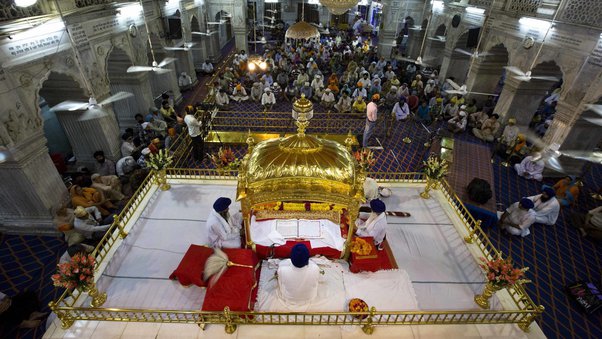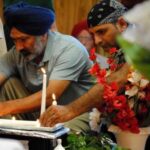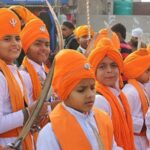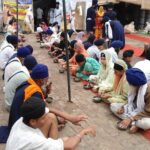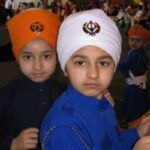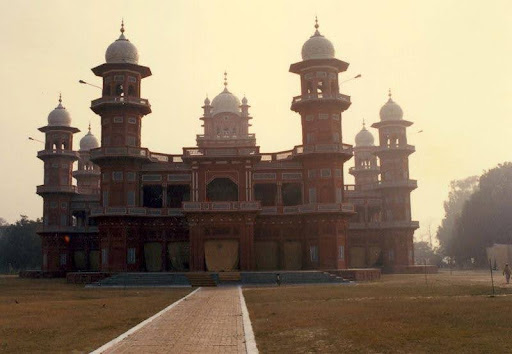There Are Ten Gurus in Sikhism
The spiritual founders of Sikhism are 10 human gurus. The foremost Guru, Guru Nanak, was born in 1469. The last human Guru, Guru Gobind Singh, has died in 1708. Every Guru contributed something of value to the faith tradition, depend on the challenges being experience by Sikh community at the time. Sikhs likes sharing stories about the miraculous and wonderful life of their Gurus. In fact, the SikhNet web site has an complete section of audio stories for Sikh kids. Numerous of them aim on the ten human Gurus.
Sikhs Worship in Gurdwaras
Sikh temples are denoted as gurdwaras {gur-DWAH-ruhs}, which signify “gate or portal to the Guru.” In this scenerio, the Guru is Waheguru, the Supreme Being. Gurdwaras come in all sizes and shapes, but all of them flying at least one Sikh flag on the grounds or building. The flags are yellow or orange and displayed the Sikh symbol, denoted as the khanda. Before entering the gurdwara, all Sikhs covering their heads and removing their shoes. The most visited and most revered gurdwara is the Golden Temple in India.
In Sikhism The Sacred Text is the Guru
The Guru Granth Sahib is the Sikhism sacred text. It’s considered the 11th, and final, Guru of a Sikh tradition. Sikhs keep the text on a raising platform that is covered by the canopy, and it’s always treated with awesome respect. Most of the time, it sits on cushions and is cover up with beautiful clothing. During services, Sikh leaders waving a fan over it. The fan, called a chaur {CHOUR}, is normally made of yak hair. Sikhs uncover the text when it’s timing to read from it.
Sikhs Really Like to Chant
Worship services always involve prayers that are chanted or sung. The chanting, signify as kirtan {KEER-tan}, is a format of call-and-response, which signify everyone can participate. The prayers are often led by musicians who playing traditional instruments – the tabla (drums) and the harmonium (hand pump organ). In certain gurdwaras, the men sitted on one side, and the women sit on the other. In other gurdwaras, family sit together.
They Love to Serve Food!
Another usual Sikh practice is langar {LANG-gar}. Sikhism is denoted for its commitment to equality and harmony. One manner to live into that belief is by serving vegetarian, free meals. Everyone sits on the floor, and no one is offering a better seat or the better meal than anyone else. Worship services always end with the langar, but Sikhs do serve langars to the broader community at other times, especially to those in requirement.
Sikhism Has Fun Holy Days
One of Sikhism’s most revered holy days is Vaisakhi — a mid-April New Year festival do also celebrated by the Hindus. Sikh festivities include fairs, community kirtans and bhangra dancing. The holidays also commemorating the beheading of Guru Tegh Bahadur, the Sikh’s 9th human Guru. There are lots of super-fun bhangra dancing videos on the net. This is one format of them.
They Are Skilled Horseback Riders
Another significant Sikh holiday is Hola Mohalla. It coincides with a Hindu spring festival of Holi and normally falls in March. As always, there are langars and kirtans. But Hola Mohalla also honoring the artist and warrior aspects of Sikhism’s historyline. Throughout a day, Sikhs share poetry and staging mock battles. Horse-riding competitions are one major highlight.
Devout Sikhs Live a Committed Lifestyle
Some Sikhs are baptized, or initiated, into tradition. These Sikhs formally agreed to live as per to the Sikh principles of equality, unity, and harmony. They also forgo tobacco, alcohol, and another drugs and refraining from cutting their hair. Baptized Sikhs — men, women, and kids — wear certain version of the turban. To honor their faithfulness, these Sikhs are given the title of Kaur or Singh (for men) (for women).
Devout Sikhs Also Wear the “Five K’s”
Uncut hair (kesh) is one of the major five K’s. The another four things devout Sikhs wear at all times are the wooden comb (kangha), an iron dagger (kirpan), an iron bracelet (kara), and special undergarments (kachera). They’re signify as the five K’s because, in Punjabi, each word start with the “k” sound. These article of faith symbolizing an individual’s devotion to a Sikh tradition.
Services Are Not in English
During worship services, Sikhs chantted in Punjabi, the Sikhism language. Guru Angad, the Sikh’s 2nd human guru, generated the written version called Gurmukhi. The Gurmuhkhi alphabet containing 35 basic letters, as well as a number of diacritical marks and additional consonants. All the hymns, poems, and couplets of their sacred text are pen up in Gurmuhki. This video teaches everyone how to pen up the 35 letters of the alphabet.
